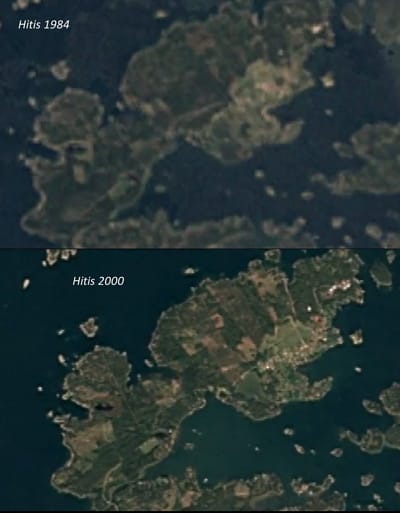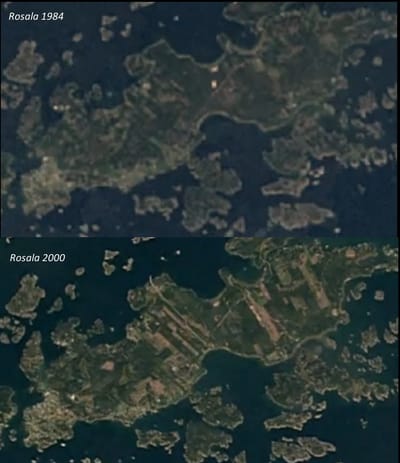The forest now and before


25 years ago, the islands still consisted mostly of forests in natural state. It was difficult and expensive to practice forestry as the ferries did not take larger cars, or cars at all, in any large amount. The villagers managed their forests themselves. They took firewood and timber as needed, in such a way that biodiversity and natural forest environment remained. Summerguests came here to relax and enjoy the tranquility, here were few people and much nature. Berries and mushroom pickers could walk for several hours from place to place.
Hitis and Rosala have an area of about 12 km² (* karttapaikka)
A small part of this has long been the villages themselves, and then some dwellings with associated land between the villages in the forest. And the rest were cliffs, forests and marshes in a natural state.
Of this, only about 53 hectares (0.53 km²) of forests are left in its natural state. (* We came to this conclusion by surrounding the natural forests on the map at karttapaikka webpage year 2020).
In 1994, the new ferry Aura began to operate between Kasnäs and Långnäs, which led to a lot of improvements on the islands. At that time, forestry was also greatly facilitated.
We now have numerical areas were forest has been completly clearcut on the islands, and the rest is young economy forest, thinned and plowed so that moss, lingonberry and other vegetation in the forest have been destroyed. Large parts of forest have been left in such a state that it is difficult to move in the forest. The wetlands have been largely destroyed, although there are a few pretty ones left.
The forest owner has the right to make all decisions regarding his property, this is as it should be. The forest owner is also entitled to all information and options, before making these very important decisions. It is a big responsibility to have the power to decide the fate of primal forests on islands as small as these are.
When contact occurs between the forest owner and a forestry company, all alternatives should be discussed. Especially if it is not an economy forest. Many people cut down their forest because they think they have to follow the forestry plan, or because they need income to pay, for example, taxes. You do not have to follow the forestry plan, it is voluntary. And you don't have to cut down your old favorite forest to pay the inheritance tax. If you want, you have other possibilities. :)
A new situation for our islands.
From having had almost exclusively forests in natural condition, or very lightly thinned forests that the owner managed himself, we now have a completely new and unique situation for the forests on Hitis and Rosala.
And the only thing that never changes is that everything changes. But it is up to us to decide how.
Maybe we can find a middle ground somewhere between improved economic opportunities for forestry, and improved economic opportunities to save natural forest? Maybe the vision can be both thinned economic forests that grow between harvesting, and that we manage to save the forests in natural conditions that give our islands beauty and and a unique natural value? The primeval forest that grows out on archipelago islands are not abundant in the world. It can give us international status and tourists may want to seek out our unspoiled nature.
It can also give us something as humans. If you have chosen to live in the archipelago, it is probably at least to some extent because you appreciate living in close proximity to nature, and you are proud of our islands. Let's take care of them together.


